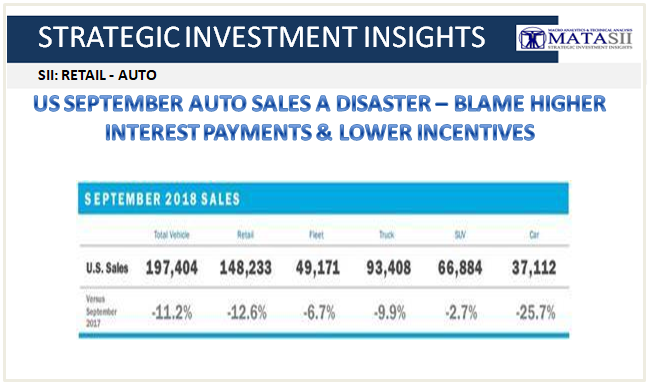US SEPTEMBER AUTO SALES A DISASTER - BLAME HIGHER INTEREST PAYMENTS & LOWER INCENTIVES
-- SOURCE: 10-02-18 - "September U.S. Auto Sales Plunge, Most OEMs Miss Pessimistic Estimates" --
It has been an extremely ugly month for car makers.
Results from Ford, Honda, Nissan, Toyota and Fiat all tell the story of an industry that had a terrible month, with few silver linings. Three of these names posted double digit percentage declines in YOY sales and three of them missed analyst estimates.
Here are the lowlights from across the industry:
- Ford posted an 11% drop, missing analyst estimates of 9.1%. The F-Series pickup line ended a 16-month streak of sales gains. Mustang sales were down 1.3%.
- Nissan posted a 12.2% drop in September. Nissan and Infiniti brand car sales fell by 36%, including a 28% drop for the Altima sedan as the company prepared to start selling an all-new version this week.
- Toyota sales were down 10.4%, far below estimates of 6.7% for the month. Combined sales for Toyota and Lexus brand cars fell 25.3%.
- Fiat posted the only true "beat", as sales rose 15% versus analyst estimates of 8%. However, the Chrysler brand fell 7% to 14,683 vehicles and the Fiat brand fell 46% to 1,185 vehicles. The deficit was made up on Jeep sales, which were up 14%, as well as sales of Ram pickups and minivans.
- Volkswagen of America car sales were down 4.8%
- GM third quarter total sales were down 11%. The company stopped reporting monthly numbers earlier this year, with many suspecting that weakness in the production pipeline is responsible; they were right.
Ford also posted an astounding drop in car sales, which fell 25.7% as a segment.
As we had previously predicted, the lack of incentive outlays seemed to be the primary driver for the poor numbers.
The impact of shrinking incentives was best observed in many of the "mainstay" sedan models among U.S. households, as many are switching to trucks and SUVs:
- Honda Civic sales were lower by 30%
- Honda Accord sales were lower by 15%
- Toyota Camry sales were lower by 20%
- Toyota Corolla sales were lower by 36%
Most manufacturers found their strongest points with trucks and SUVs. Nissan, for example, saw combined truck sales rise 6.6%. This included gains of 71% for the Frontier mid-size pickup and a 57% gain for the Titan. The Rogue SUV was down 11%. Fiat outsold Ford, 199,819 to 196,496 in cars, SUVs and light trucks.
For Toyota, Highlander and 4Runner SUV sales rose, cauterizing Toyota's light truck sales decrease at just 0.3%.
Vehicle ASP seems to be the "silver lining" that many optimists are trying to pull from this otherwise terrible month. Kelley Blue Book reported that the industry average price paid at dealerships was $35,742, a gain of 2%, while the average Ford buyer paid $36,040, up $1,500 from last year. According to Cox Auto, the average new vehicle price rose $687, or 2%, from September last year.
That however may be at the expense of still easy loans: the average new car loan jumped $724 year-over-year to $30,958 in Q2 2018, while used vehicle loan amounts increased $520 to reach $19,708, both records.
Many OEMs blamed the poor YOY numbers on last year's Hurricane Harvey, which spurred more buying in its aftermath to make for tougher comps and this year's Hurricane Florence, which is being blamed for a lack of buyers.
Ford’s Mark LaNeve called September a "tale of two hurricanes" on this morning's conference call. "Hurricane Florence was a big factor this month."
Others chose to leave the past in the rearview mirror and focus on the future: Kurt McNeil, GM U.S. vice president for sales, was looking forward to Q4: "Our brands are very well-positioned for the fourth quarter when our next wave of new products start shipping in high volume."
However, experts at AutoTrader still see headwinds for the industry as a result of rate hikes.
Michelle Krebs, senior analyst with researcher AutoTrader, said: "It's a very hard comparison with last year. But we do see headwinds building, with higher interest rates being the major one. We anticipated the last part of the year would be challenging and now we're seeing that. Wages aren't rising fast enough to keep up with inflation and that is keeping some people out of the market."
Just days ago, we outlined that September was shaping up to be a brutal month for auto sales. At the time, estimates released by Edmunds were expecting a new vehicle sales collapse both on a monthly basis and year-over-year basis. Edmunds predicted that 1,392,434 new cars and trucks would be sold in the U.S. in September, which equals a estimated seasonally adjusted annual rate (SAAR) of 17 million.
At the time, Jeremy Acevedo, Edmunds' manager of industry analysis, stated: "Vehicle replacement demand following Hurricane Harvey bolstered auto sales last September, and Hurricane Florence has had a very limited impact on auto sales this month, which are the primary reasons why we're seeing this year-over-year decline. With that said, a SAAR of 17 million is certainly not an unhealthy number — September is still shaping up to be a robust month for sales."
On the other hand, with rates ticking up again since then and making auto loans and leases that much more expensive with the average new car payment hitting a record $525 per month...
... it is debatable whether the picture will get any more "robust" in October, or the rest of the year for that matter.







